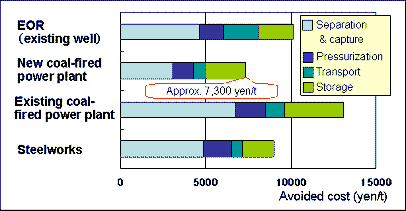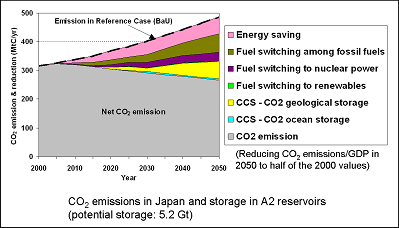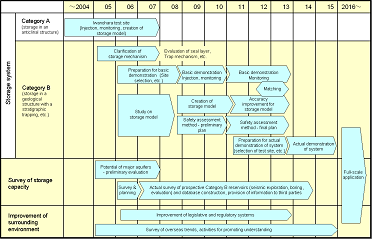 |
 |
|
Evaluation of Effectiveness Purpose To tackle various technical problems related to CO2 geological storage and to show its effectiveness, the following endeavors were conducted.
Cost Analysis The CO2 geological storage systems were divided into four types and their costs were analyzed based on the hypothesized actual-scale injection plan adopted in the model site survey. According to this estimate, the costs of geological storage using presently-available technologies is 7,000-15,000 yen per ton. Typical cost analysis based on the model site survey

It was revealed that the relevant costs in Japan, particularly the transport and storage costs, are much higher than those in overseas countries. The transport cost in Japan is high because the vehicles pass through densely-populated areas. The storage cost is also high because Japanese formations have a low permeability compared with those found in overseas countries and thus the injection amount per well is rather limited. Comparison of geological storage costs between Japan and overseas countries
Based on the above comparison, the following must be addressed hereafter for actual application.
Overall Economic Evaluation In the overall economic evaluation of CO2 geological storage, a mathematical model was constructed and a cost analysis and a storage capacity survey were performed. The geological storage costs in Japan are relatively higher than those in overseas countries. However, we have little option in terms of ways to reduce CO2 in large scale at a low cost, because the potential of renewable energies is limited and because the energy-saving aspect has already been largely exploited. Therefore, even though the geological storage costs are higher than those overseas, it is still relatively inexpensive compared with other measures. Thus, it can be said that the important function of geological storage has been demonstrated quantitatively. In the cost calculation for A2 type reservoirs (potential storage capacity: 5.2 Gt ), for which basic boring data exists, it was found that about half of the storage would be economically justified if the CO2 reduction target per GDP in 2050 was set at half of the 2004 emissions. This suggests that as the reservoir area is expanded in the future, the economically-competitive storage capacity would be increased significantly. CO2 emissions and storage capacity in Japan
 Click to enlarge Road Map Based on the various effectiveness scenarios as well as overseas trends in CO2 geological storage, the issues that need to be addressed were extracted and a road map was prepared by setting FY2015 as the start for full-scale implementation. The road map is aimed at defining a route for technological development and its diffusion as well as promoting understanding on geological storage among companies having large-scale emission sources. In the actual implementation of geological storage, cost reduction is very important. The separation and capture costs which presently comprise a large percentage of the overall total must be reduced. The transport costs must also be drastically cut by focusing on the distance between emission sources and the reservoirs, etc. For this to happen, it is necessary to explore the technical storage potential of Category B aquifers, which are widely distributed in the coastal areas near emission sources, through basic demonstration tests, and to construct a storage model based on the test results. It is also necessary to conduct storage capacity surveys in coastal areas near the emission sources, together with the promotion of activities for a better understanding of geological storage. Road map for CCS in Japan
(Source: "CCS2020" by the Industrial Science and Technology Policy and Environmental Bureau, the Ministry of Economy, Trade and Industry (METI))  Click to enlarge Achievements
Future Challenges
|
|||||||||||||||||||||||||||||||||||||||||||||||||||||||||||||||||||||||||||||||
|
|||||
|
|
